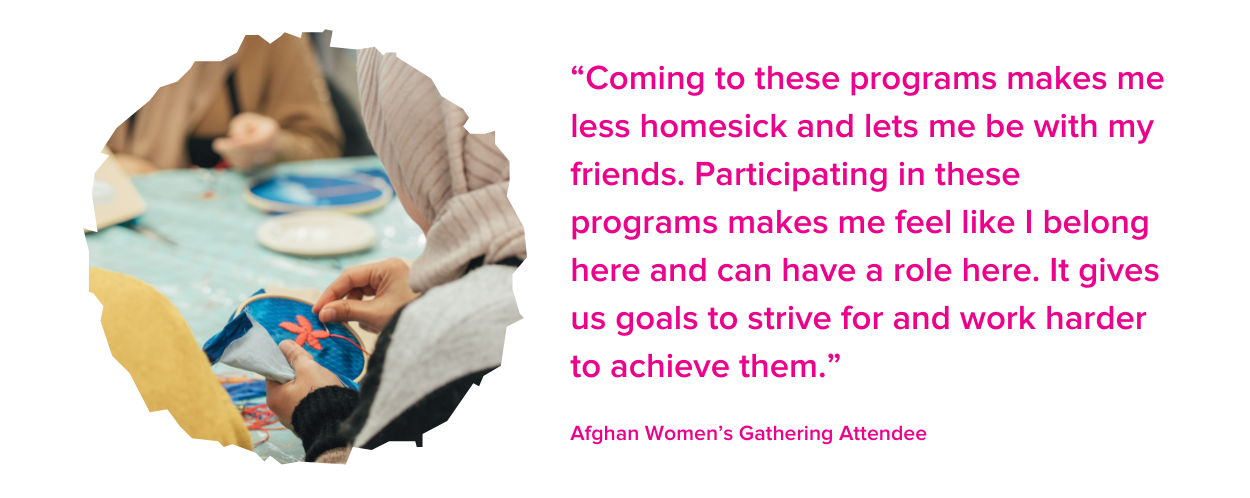Written by Sarah Dawson McClean, Communications and Public Affairs Manager for ARTogether
In today’s world, where migration is often driven by conflict and the search for safety, immigrants and refugees face unique challenges as they try to settle into new societies. Leaving behind one’s homeland, resources, careers, culture, and language is incredibly heartbreaking and challenging, and rife with setbacks and loss. Building a new life for their families from nothing, along with combating the isolation that comes with cultural barriers, the pressure to adapt quickly is overwhelming.
However, art has the power to help bridge these gaps. It offers a way to heal, express oneself, and connect with others. Through creative expression, individuals can maintain a connection to their roots while adapting to a new culture, finding a healthier balance between where they’ve come from and where they are now. When this balance is missing, people may feel excluded or lose touch with their identity. Art creates space for belonging, resilience, and community, helping people feel seen and supported in their new environment.

Social support systems for first-generation immigrants and refugees are often limited. Government policies (at their best) prioritize basic needs such as housing and employment, leaving gaps in social and emotional well-being services. Nonprofits and community organizations step in to fill these voids, but most focus understandably on education and employment support, rather than identity-building and mental health support. This is where art becomes a powerful tool.
Healing Trauma Through Art Therapy
Migration often involves significant trauma, from pre-migration struggles such as war and persecution to post-migration discrimination and cultural isolation. Studies have shown that immigrants who experience pre-settlement trauma are more vulnerable to mental health challenges, particularly when they face racism and exclusion in their new homes.
Art therapy has emerged as a proven intervention for trauma healing. The American Art Therapy Association highlights that the process of creating and reflecting on art can increase self-awareness, reduce stress, and enhance emotional resilience. Techniques such as storytelling through visual art, narrative exposure therapy, and interactive creative play have been used to help refugees and asylum seekers process trauma.
At ARTogether, we intentionally combine art and wellness as a core part of our work with immigrant and refugee communities. Our programs create welcoming, creative spaces where participants can process trauma, explore their identities, and connect with others. Whether it’s through community workshops, art therapy sessions, or youth-led projects, we aim to support healing, confidence-building, and a deeper sense of belonging.
Art as a Shared Language and Community Builder
Beyond its therapeutic benefits, art serves as a universal language that transcends cultural and linguistic barriers. This is especially crucial for immigrants and refugees, who face communication barriers in their new environment. Artistic expression allows individuals to convey their emotions, tell their stories, and connect with others.
A powerful example is ARTogether’s Art Lab for Newcomers program at Concord High School, which creates a safe space for immigrant and refugee students to build social connections, gain confidence, and feel a stronger sense of belonging in their multicultural community. Similar programs have shown that arts education can improve social skills, emotional awareness, and relationships among diverse groups.
The Need for More Art-Focused Support Programs
Despite the evident benefits of art therapy and community-based art programs, they remain underutilized in immigrant and refugee support systems. Most social services focus on housing, employment, and language development. Meanwhile mental health and identity-building initiatives are often overlooked.
Now more than ever, it is urgent that we support the immigrant and refugee community. We use art as a welcoming method to foster a safe space that has the ability to tie creativity with wellness. Art is more than just a creative outlet. It is a lifeline for immigrants and refugees navigating the complexities of acculturation, identity, and healing. Whether through therapy, community projects, or professional artistic pursuits, engaging art can be a way to share stories, build resilience, and foster a stronger connection to their new home. By recognizing and investing in art, we can create more inclusive and supportive societies for those who need it most.



